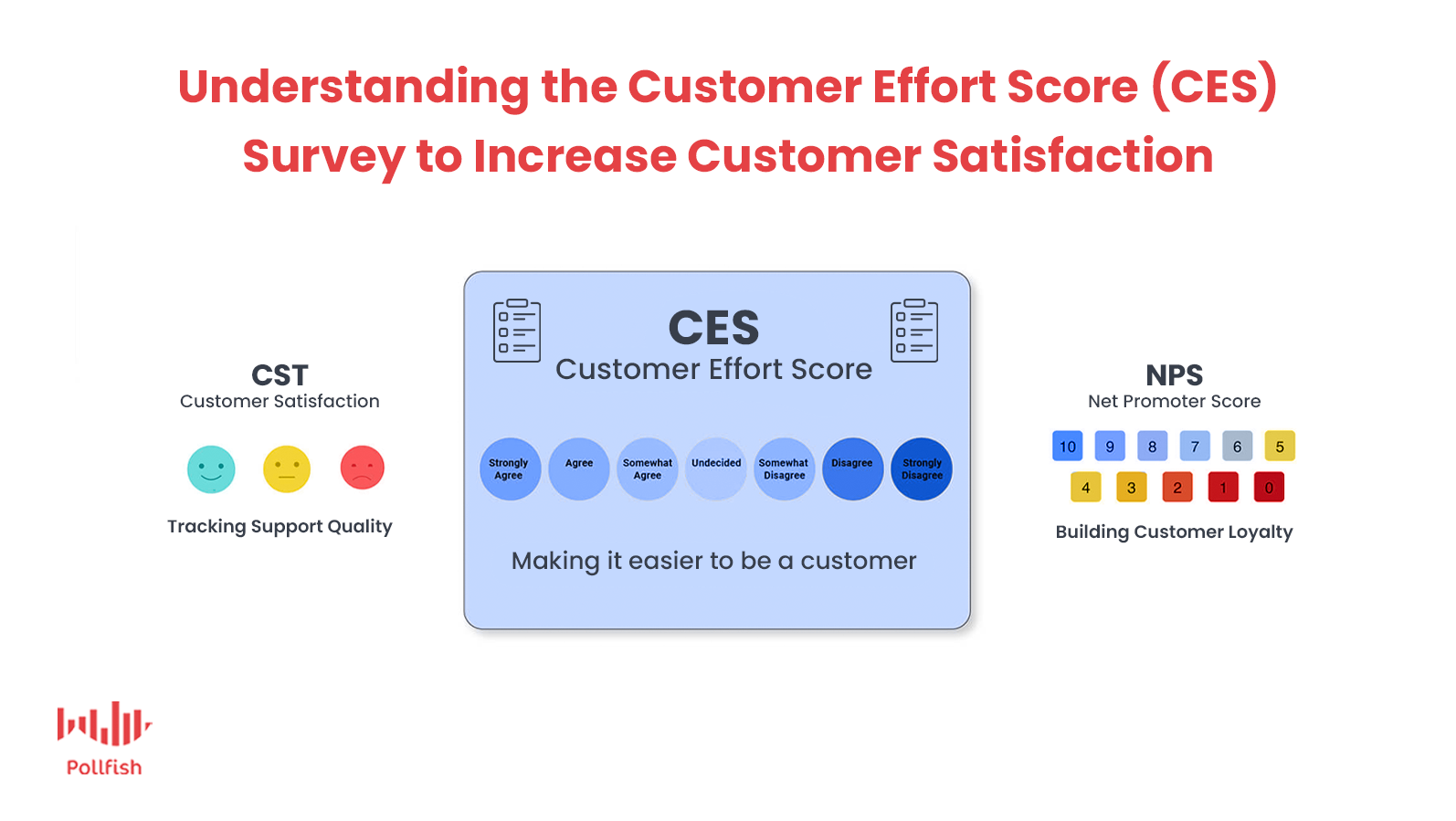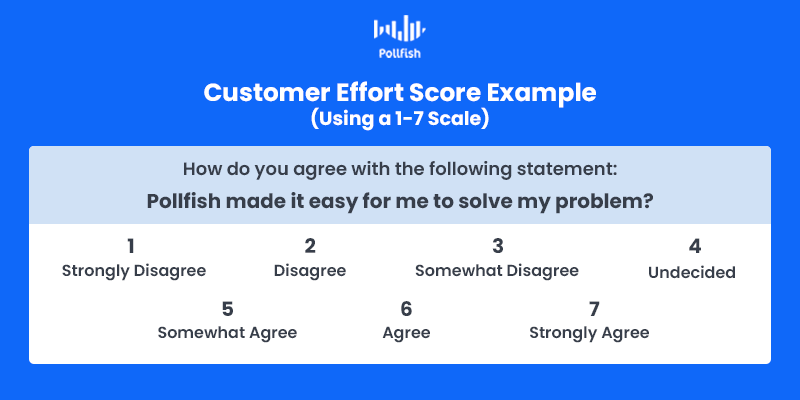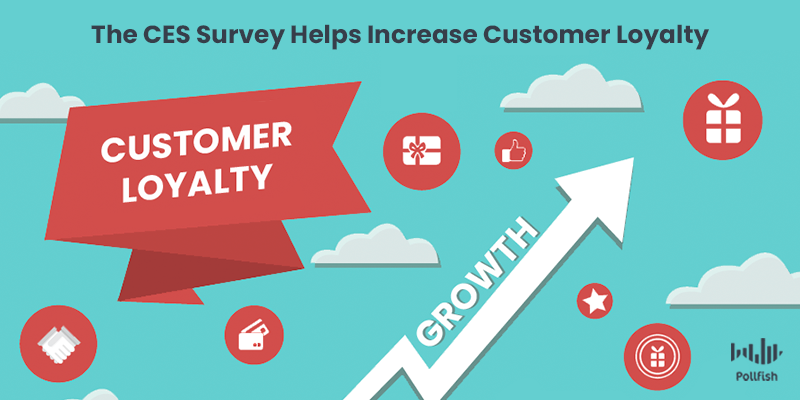Diving Into the Customer Effort Score (CES) Survey
 The Customer Effort Score survey, or CES survey, is one of the foremost customer satisfaction surveys. As a business owner or marketer, you ought to know that customer satisfaction holds colossal importance for your business.
The Customer Effort Score survey, or CES survey, is one of the foremost customer satisfaction surveys. As a business owner or marketer, you ought to know that customer satisfaction holds colossal importance for your business.
It can help drive customer loyalty, the key force behind retention, which ensures your customers return to your business instead of making one-time only purchases. Additionally, when brands produce high levels of customer satisfaction, they are increasing their customers’ Customer Lifetime Value (CLV), which incites higher value from customers.
Furthermore, customers want to know that their input is collected and valued, as 52% of worldwide customers believe that businesses need to take action on their feedback.
The CES survey is a potent survey tool to assess customer satisfaction — but it takes a very specific angle — that of measuring customer effort.
This article delves into the CES survey, explaining customer effort, why it’s important to measure it and all other key information so that your business makes the most out of this survey type.
Defining the CES Survey
Like its name implies, the Customer Effort Score survey measures customer effort, which is the degree or amount of effort that a customer puts into a certain interaction with a company.
Specifically, the CES survey is a survey that calculates the eponymous Customer Effort Score, a key customer experience metric that gauges customer effort.
Understanding Customer Effort
Customer effort refers to the degree of difficulty a customer has undergone to try to get an issue resolved. Additionally, it also generally refers to the ease (or difficulty) that a customer experienced with a certain service or experience with a company.
Understanding the Customer Effort Score
The Customer Effort Score is the heart of the CES survey. A customer experience (CX) score, it asks customers to rate the ease of completing an action — the customer effort in question; this is usually expressed on a scale of either “very difficult” to “very easy.”
The Customer Effort Score has a flexible setup: it can be derived from a scale of 1-5 and 1-7; it can be numeric and text-based.
There are 2 versions of the CES scale:
- In the older version, a 5-point scaled question asks: “How much effort did you use to complete this task?”
- In this scenario, 1 represents a very low effort, while 5 represents a very high effort.
- Thus the lower the number, the better the CES score, while a higher CES score meant more difficulty, therefore a bad score.
- In the newer version, a 5 (or 7, or 10-point) scaled question asks: “How much do you agree with the following?: The company made it easy for me to handle my issue.”
- This version presents a disagreement/ agreement rating scale.
- 1 represents “strongly disagree” while 5 or 7 represents “strongly agree”, so the scale is from negative to positive, (a higher number represents a better CES score), unlike the first version.
Calculating the Customer Effort Score

As you can gather, there are various ways to crunch customer effort, that is to derive a rating on customer effort. Once you’ve gotten a number from the scale (based on what your respondents answered with), you can take this further to determine the CES score.
There are several ways to calculate the Customer Effort Score. You can use whichever method you prefer for your CES survey. Either way, you’ll be a step closer to working out your customer satisfaction, most notably the degree of your customer effort.
Here are the three calculations to determine your CES:
- Average score: Used with the 1-10 scale. Get the complete sum of all the CES scores and divide it by the number of responses.
- Ex: total CES scores= 600, total respondents = 100
- 600/100= 6, CES= 6, i.e., 6 out of 10
- Via the Agree/Disagree scale or emojis (happy faces): Can be used with 1-5 or 1-7 scales. Subtract the percentage of positive responses from the percentage of negative responses. Do NOT use the neutral responses in the calculation.
- Ex: Total respondents = 300, positive responses =250, negative responses= 50
- % of positive responses = 83.33%, % of positive responses= 16.666%
- 83.33%- 16.666% = 66.664%
- CES score = 66.664%
- Via the 1-7 Disagree/Agree scale: Divide the total number of 5-7 responses (Somewhat Agree – Agree – Strongly Agree) by the total number of respondents. Then, multiple the result by 10 or 100 (if you prefer a percentage).
- Ex: total respondents = 200, 95 = number of positive responses
- 95/200 = 0.475
- 0.475 x 10 = 4.75, CES = 4.75 or
- 0.475 x 100 = 47.5%, CES = 47.5%
Remember, the higher the CES number is on the scale, the greater the Customer Effort Score. So which numbers are positive and which are negative?
- On a 1-7 scale, 5-7 are the positive answers, as they represent somewhat agree – agree – strongly agree.
- 1-4 are the negative responses; 5 is neutral.
- On a 1-5 scale, 4 and 5 are the positive responses.
- 1-2 are the negative responses; 3 is neutral.
- On a scale of 1-10, numbers 8-10 are the positive responses.
- 1-5 are the negative responses; 6 and 7 are neutral.
Why Your Business Needs a CES Survey
A high Customer Effort Score, to put it plainly, is good for business. As such, businesses need to measure their CES score periodically, to track how their customer effort is faring with customers.
A high score signifies that your company is making things easy for your customers.
A low score denotes that interacting with your business — even if it only concerns one aspect of it — is difficult for customers, as it requires too much effort from them.
Exceeding customer expectations is of the essence when it comes to retaining them. In order to create customer loyalists, you need to maintain a high Customer Effort Score, as it is the primary factor of customer satisfaction, along with loyalty and disloyalty.
According to Gartner Research, customers are 4 times more likely to be disloyal after they’ve had a service interaction. These unsatisfied customers negatively affect a company, as they spread their dissatisfaction via social media, forums, online reviews and word of mouth.
What’s more, is that a whopping 96% of customers with low CES scores become more disloyal to a business, as opposed to the meager 9% with high CES scores.

Brands need to make their CX as seamless as possible, so that customers require little to no effort when navigating through brands’ services and experiences.
A CES survey is the aptest instrument for measuring the Customer Effort Score, as it allows businesses to ask the CES question plainly in various parts of a customer journey.
Additionally, this survey is not limited to merely one question, as brands can allow respondents to expound on their score with follow-up questions particular to the interaction customers had just rated.
When to Use a CES Survey
Businesses ought to use a Customer Effort Score survey at various points in their customer experience. Here are a few of the most critical moments to send a CES survey to your customers and customer base:
- After a customer service interaction: whether it’s via phone, email, in-store or via chat, these are critical interactions that must be kept effort-free.
- Following a browsing session: after a customer visited several product pages, send the CES survey to understand whether it was easy for them to find what they were looking for.
- After an on-site search or navigation: Piggybacking off of point 2, gathering customer effort feedback is crucial after customers searched for pages within your site, via a search tab or navigation, as this shows you whether they can easily find what they need.
- After a purchase: This can be used to evaluate the ease of use of the checkout, including all of its steps, or about the steps (pages visited in the customer journey) that led to the purchase.
- Site revisit after no purchase: While it’s disappointing that customers left your site without purchasing if they’ve returned to your site, that’s good news. The CES survey allows you to gain insight into what about the checkout or other aspects of their CX led them to leave without purchasing.
The Pros and Cons of the CES Survey
The CES survey offers businesses a variety of benefits. There are also some setbacks to bear in mind before you launch a CES survey campaign. The following lists the advantages and disadvantages of the Customer Effort Score survey:
The Pros:
- Measures specific actions and events in a customer journey, allowing brands to zero in on what needs improvement the most.
- Allows companies to understand how to improve their CX at an overall level.
- Shows customers that your brand cares about their ease of use with your experiences.
- Boosts customer retention, as customers with high CES scores tend to make repeat purchases (as aforesaid).
- Low-effort interactions create lower costs — 37% less than a high-effort experience (Gartner, see above link) for a business.
- Increases customer loyalty, as fewer customers abandon a business that they are loyal to.
- Helps improve other customer satisfaction metric surveys, such as the NPS.
The Cons:
- Less adoption than the CSAT and NPS surveys.
- Less usage also means fewer benchmark data available to understand which scores are ideal, which are natural, etc.
- Limited to specific experiences.
- Not every customer will want to take a survey at every touchpoint.
Using Customer Effort to Scale Business
Customer satisfaction is the core of a business’s success, as happy customers will return, while dissatisfied ones will not only abandon a company, but leave their mark of discontent on the internet and elsewhere.
Businesses, therefore, need to monitor their customer satisfaction. There are several surveys that help businesses determine the state of their customer satisfaction. The CES survey, however, is unique in that it is the only survey dedicated to measuring customer effort.
Customer effort is a key hurdle (or non-hurdle when it’s low) to satisfaction. A high effort (meaning a low CES score) damages customers’ CX, thereby causing a dent in their customer satisfaction.
Your CX must be as seamless as possible so that the effort required to take any action from customers is hardly noticeable. This may seem like a tall order, but it isn’t, largely due to the CES survey. This survey helps brands study their customer effort at virtually any part of their CX.
The key is to find a strong online survey platform that can facilitate the Customer Effort Score survey process.
Frequently asked questions
What is a CES Survey?
Customer Effort Score (CES) survey determines the amount or extent of effort a specific customer puts into a particular interaction with a business.
What is customer effort?
Customer effort refers to the level of difficulty a particular customer has experienced to resolve a problem. In addition, it also typically refers to the difficulty or ease that a customer experiences with a specific service of a company.
How can you determine the CES score from a CES survey?
Businesses can deduce their CES score in 3 ways:
Average Score: Surveys using a 1-10 scale point can get a sum of all the CES scores and divide it by the number of responses
Agree/Disagree Scale: These surveys have a 1-5 or a 1-7 scale. Subtract positive responses from negative responses to get a CES score
1-7 Agree/Disagree Scale: These are responses that vary between the options of Somewhat Agree – Agree – Strongly Agree – Disagree – Somewhat Disagree, and so on
Why does your business need a CES survey?
CES (Customer Effort Score) is essentially used by businesses to track how effective their customer care is at dealing with customer's complaints and issues. To maintain a steady influx of buyers, companies should strive to maintain a higher CES score.
When should businesses use a CES survey?
Essentially, a business should use a CES survey to assess how easy or difficult a particular touchpoint has been for their customers. It is conducted to gauge the customer experience.
Pollfish Marketing Team
Ready to Try Pollfish?
Create your survey with AI, target high-quality respondents starting at $0.95 per complete, and start getting results in just minutes in real-time. From running a simple product concept survey to managing a constant stream of trackers for dozens of clients in dozens of countries, we’ve got you.
